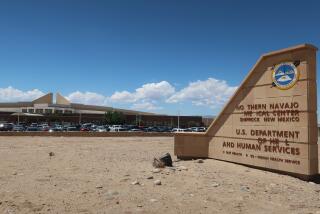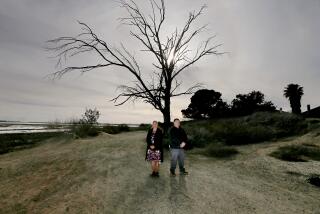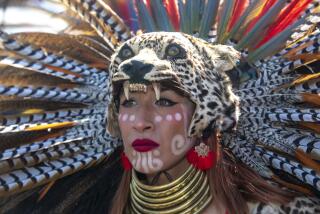Catholic Indians : Pipe Prayers and Mass: 2 Rituals Blend
- Share via
Medicine man John Hascall fanned the smoldering embers of sage leaves and sweet grass with a large eagle feather, sending the billowing white smoke toward the circle of Native American worshipers gathered Sunday for a pipe prayer ceremony.
“I pray that you will be strong . . . and come to understand our Indian ways,” Hascall said in English after praying in the Ojibway language.
Laying gifts of cedar chips, spice and tobacco on an Indian blanket where he sat cross-legged, Hascall offered them to “Grandfather God” and prayed for the “coming of spring to Mother Earth.”
Ojibway medicine man Hascall is also a Roman Catholic priest.
A few minutes after he passed a wood-and-stone prayer pipe among the 75 gathered at the parish school in Lincoln Heights, he celebrated Mass across the street in Sacred Heart Catholic Church.
Hascall sees no contradiction in his roles.
“We are Native American people living the Catholic Christian life in our Native American way,” he said.
A Franciscan priest for 20 years in Michigan and Canada, Hascall for the last eight months has been president of the Tekakwitha Conference of Native Americans based in Great Falls, Mont.
The combined religious rituals in Los Angeles had the blessing of the church’s pastor, Bishop-elect Armando Ochoa, the second Latino bishop to be appointed to the 2.65-million member Archdiocese of Los Angeles. He and two other priests will be ordained as auxiliary bishops of the three-county archdiocese Feb. 23.
Ochoa said the pipe ceremony and Mass marked the first time a Native American Catholic group had come together in Southern California to celebrate their dual customs.
“Don’t be afraid to be who you are. . . . Keep alive the faith traditions of your ancestors,” Ochoa told the group after puffing on the red-and-gray ribboned prayer pipe.
In an interview after the Mass, which featured recorded Indian drum music and a purification ceremony performed with burning sage and the eagle feather, Hascall said it has only been in recent years that the Catholic Church has come to accept the compatibility of Native American ways and Christian faith.
“The church is growing up. It is understanding what the reforms of Vatican II are all about,” Hascall said. “We Indian people have the responsibility to understand the ceremonies of our culture, love ourselves for who we are--and so pass on the tradition.”
No Native American Catholic bishop was appointed in this country until May, 1986, when Donald E. Pelotte was named the coadjutor of the Diocese of Gallup, N.M.
The Tekakwitha Conference sponsors events like the one Sunday throughout the United States, Canada, Mexico and South America. Last year, it brought together 4,000 Native Americans from 150 tribes for a spiritual retreat in Montana. Tekakwitha is also in charge of rounding up about 15,000 Native Americans from throughout the Western United States for a meeting with Pope John Pope II in Phoenix this September during the pontiff’s nine-day U.S. tour.
At the same time, Tekakwitha Conference leaders are pushing Kateri Tekakwitha, who would become the first Native American to be canonized, along the path to sainthood.
The 17th-Century Mohawk woman lived a life of prayer, penitence and caring for the sick near Montreal until her death at age 24. She was declared “blessed” by Pope John Paul II during beatification ceremonies--the second of three steps to canonization--in Rome in 1980.
Hascall and other Native American Catholics say they hope the Pope will proclaim Tekakwitha a saint during his U.S. trip this summer, and they point out that her cause is further advanced than that of Father Junipero Serra, the Franciscan friar who founded the California mission chain.
Serra supporters predict that the Spanish missionary will be beatified during a papal Mass in Monterey on Sept. 17.
Hascall said Sunday that the Tekakwitha Conference is preparing a statement opposing Serra’s beatification “at this time.” Indian people “would like to see it put off a while” because of Serra’s reputation for mistreating Indian converts, Hascall said.
Some historians have alleged that Serra allowed his workers to beat the Indians and that he subjugated them to forced labor and demolished their culture, charges dismissed as unfounded or distorted by pro-Serra researchers.
More to Read
Sign up for Essential California
The most important California stories and recommendations in your inbox every morning.
You may occasionally receive promotional content from the Los Angeles Times.










